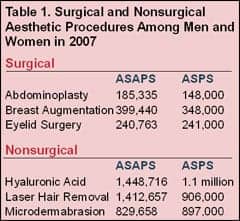According to the latest statistics released by the American Society for Aesthetic Plastic Surgery (ASAPS), an estimated 11.7 million aesthetic surgical and nonsurgical procedures were performed in the United States in 2007—a 457% increase since the first statistics were collected in 1997.
According to the report, Americans spent more than $13 billion on aesthetic procedures in 2007.
The top five nonsurgical procedures performed in 2007 among men and women, according to the ASAPS report, were botulinum toxin Type A injections (2,775,176), hyaluronic acid injections (1,448,716), laser hair removal (1,412,657), microdermabrasion (829,658), and laser skin resurfacing (647,707).
The top five surgical procedures performed in 2007 among men and women, according to the report, were liposuction (456,828), breast augmentation (399,440), blepharoplasty (240,763), abdominoplasty (185,335), and female breast reduction (153,087).
The statistics also show that more than 10.6 million procedures (nonsurgical and surgical) were performed on women—an increase of 1% from 2006—and more than 1 million procedures (nonsurgical and surgical) were performed on men—an increase of 17% from 2006.
No sizeable differences were found between the ASAPS data and the 2007 statistics recently released by the American Society of Plastic Surgeons (ASPS).
An important figure found in the ASPS report was the 9% increase in minimally invasive procedures, including hyaluronic acid fillers, which jumped from the fifth most popular in 2006 to the second most popular in 2007.
 |
Other notable figures from the ASPS report: a 2% decrease in reconstructive plastic surgery procedures, including tumor removal (3.9 million, down 1%), laceration repair (286,000, down 9%), scar revision (150,000, down 9%), and hand surgery (142,000, down 9%).
“It is not surprising to me that the minimally invasive procedure numbers have increased and the reconstructive surgery numbers have decreased,” says George J. Bitar, MD, an aesthetic and reconstructive plastic surgeon who practices in Fairfax and Manassas, Va. “With minimally invasive procedures having been on the market a few years, patients are more familiar with them and less intimidated by them. They are relatively easy to do, quick, and less expensive than major cosmetic procedures, such as a facelift, with less downtime.
“Plastic surgeons are moving more toward cosmetic procedures and away from reconstructive procedures for a simple reason,” Bitar continues. “The insurance reimbursement is deplorable. That fact is also driving OB-GYNs, ENTs, and family practitioners to do minimally invasive procedures as well, thus driving the numbers of Botox, laser hair removal, and hyaluronic acids, as well as other fillers, up the roof.”
The important thing for consumers to remember is that injectables and minimally invasive procedures require skill and follow-up, according to Bitar. Just because they are not surgery does not mean that they cannot have complications, he adds.
A skilled plastic surgeon who can also offer surgical alternatives to fixing the problem permanently, and not just temporarily, should be the professional of choice to seek, he says.
FACELIFTS MAKE A COMEBACK
With patients opting for less invasive procedures for facial rejuvenation, facelifts made a comeback in 2007 among female and male Baby Boomers. The statistics by the ASPS report a 14% increase for women and a 16% increase for men since 2006.
“I believe that the increase in facelift surgery is the result of two significant factors,” says Andrew A. Jacono, MD, FACS, chief of facial plastic and reconstructive surgery at North Shore University Hospital in Manhasset, NY. “The first is advances in both technique and technology in facelift surgery. Instead of more extensive traditional facelifts that often left patients with long recoveries and a less natural look, endoscopic technology, midface lifting surgery, and limited incision rhytidectomy approaches have decreased scarring, recovery time, and have created more natural results. This has been popularized by the media and well-received by the Baby Boomers in my practice.
|
See also “Show us the money” by Lesley Ranft in the December 2006 issue of PSP. |
“The second significant factor,” Jacono continues, “is the increase in competition in the business world due to a weakened economy. Baby Boomers are embracing facelift surgery to project a more youthful and energetic appearance that translates into success in their work environment.”
What were consumer attitudes about seeking aesthetic surgery? According to the ASAPS report, 56% of women and 57% of men said they approve of plastic surgery, and 31% of women and 20% of men said they would consider plastic surgery for themselves now or in the future.
In addition, 78% of women and 79% of men said that if they had aesthetic plastic surgery in the future, they would not be embarrassed if individuals outside their immediate family and close friends knew about it.


